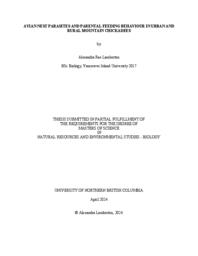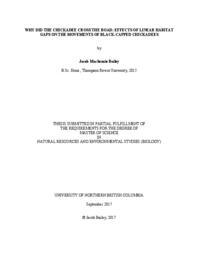Reudink, Matthew
Person Preferred Name
Matthew Reudink
Related Works
Content type
Digital Document
Description / Synopsis
Urbanization is considered one of the greatest human-caused threats to biodiversity. Human development and encroachment on native habitats and its impacts on species, however, is nuanced; while it has been found to create detrimental impacts on some species, certain aspects of urbanization may benefit others. This interaction of advantages vs constraints offered by urban landscapes is especially relevant to species that show sufficient behavioural plasticity to settle in this rural/urban interface. The objective of this thesis is to investigate some of these potential costs/benefits of urbanization in mountain chickadees. I first assess a potential positive effect of urban settlement noted in other systems – a decrease in the incidence of nest ecotparasites found in urban landscapes - in mountain chickadees nesting in Kamloops, BC, Canada. I enumerated the blowflies and fleas found in collected nests in 2019 and 2020 to determine whether nest parasitism differs between urban and rural habitats in the region, and whether this in turn influences nest success (Chapter 2). I found that abundance of blow fly puparia was higher in rural nests, but that flea abundance was associated with temperature and not urbanization. Additionally, I observed that urban nests fledged approximately one additional chick per nest. This suggests urban habitats could lift some constraints that would normally decrease nestling condition. I then compared rates of adult chickadees feeding nestlings to determine whether differences in ectoparasitism levels between habitats results in compensatory feeding by parents, and if this affected the growth rate of nestlings (Chapter 3). I did not find evidence that urbanization or ectoparasite abundance influenced parental feeding or growth rate. I did find that feeding rate was lower and that growth rate was higher in warmer years. Other studies showing potential differences in prey availability between habitats, with rural sites having potentially greater abundance of prey, may help explain my results – while prey might be more abundant in one habitat, nestling condition may be less affected by parasite infestation in the other, helping balance the costs/benefits of settlement between habitats. While my results provide some evidence that reduction of parasites in urban areas can benefit urban settling species, further research will be required to determine the mechanism that causes this phenomenon.
Origin Information
Content type
Digital Document
Description / Synopsis
My thesis investigates how urban noise influences the relative audibility of songs to female Mountain Chickadees (Poecile gambeli), who assess male signalling at dawn while roosting within the nest cavity. Over two breeding seasons, I monitored Mountain Chickadees breeding on an urban/rural interface in Kamloops, BC, Canada. I broadcast typical Mountain Chickadee songs, with or without added noise, towards recently unoccupied nests while simultaneously re-recording these songs with microphones outside and inside the nest box to determine the relative audibility in relation to both distance and presence/absence of noise. I then tracked individual males’ behaviour and movement during dawn signalling, while passively recording their songs with microphones — outside and inside the nest box — to determine the relative audibility of signals from the perspective of the roosting female. The relative audibility of songs decreased with increasing distance from the nest, which was compounded by increased urban noise. During dawn signalling, urban males respond to these effects by remaining closer to the nest, resulting in their songs being more audible within the nest than their rural counterparts. Overall, ambient noise and distance had an interactive effect on relative audibility of songs, suggesting complex dynamics of communication networks that may result in a trade-off, where males are forced to prioritize directing their signals to either their social mates or neighbours.
Origin Information
Content type
Digital Document
Origin Information
Content type
Digital Document
Origin Information




